Optimizations
We performed several optimizations in order to improve the performance of our cluster.
- We decrease the video RAM allocation from 256 Mb (out of 512 Mb total) to 16 Mb
- We overclock the processesors to 950 MHz. Although, we attempted to to overclock the Raspberry Pis to 1,000 MHz, this caused system instability.
- We use a Linux kernel flag to optimize the ethernet controller by not waiting for extra frames.
- We network statically to avoid DHCP lookup.
- We change SSH security settings to avoid extra networking overhead
Relative Performance
We compared the performance of our Raspberry Pi cluster to a Core i7 Macbook Pro for two of the CS 205 homework problems:
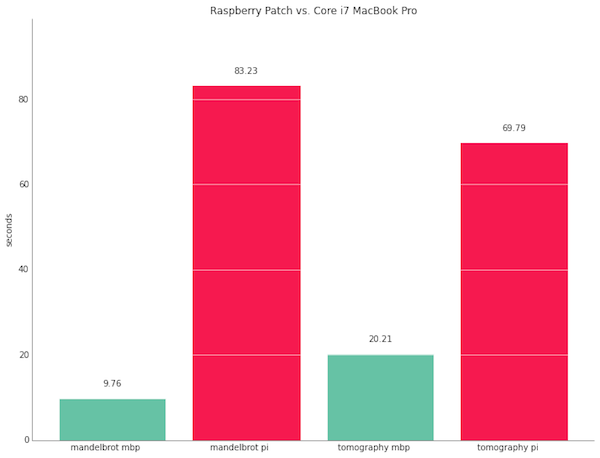
Speedup and Efficiency
For one of the homework problems (computing the Mandelbrot set) we also looked at speedup and efficiency of our cluster:
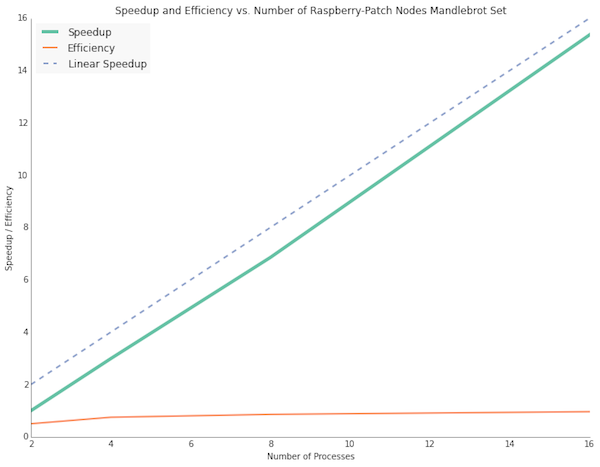
Communication Latency
In order to find any potential bottlenecks, we performed a pairwise profile of our nodes. This table provides pairwise communication latency in miliseconds for each pair of nodes. The takeaway: our slowest pair of nodes can start 35 message transfers in the blink of an eye.
| 0 | 1 | 2 | 3 | 4 | 5 | 6 | 7 | 8 | 9 | 10 | 11 | 12 | 13 | 14 | 15 | |||||||||||||||||
|---|---|---|---|---|---|---|---|---|---|---|---|---|---|---|---|---|---|---|---|---|---|---|---|---|---|---|---|---|---|---|---|---|
| 0 | 8 | 5 | 5 | 5 | 5 | 5 | 5 | 5 | 5 | 5 | 5 | 5 | 5 | 7 | 5 | |||||||||||||||||
| 1 | 10 | 10 | 5 | 5 | 5 | 6 | 5 | 5 | 10 | 7 | 10 | 5 | 5 | 5 | ||||||||||||||||||
| 2 | 7 | 7 | 7 | 5 | 5 | 5 | 5 | 5 | 8 | 10 | 7 | 10 | 5 | |||||||||||||||||||
| 3 | 10 | 5 | 10 | 5 | 10 | 10 | 7 | 7 | 10 | 5 | 5 | 5 | ||||||||||||||||||||
| 4 | 5 | 5 | 10 | 5 | 5 | 10 | 10 | 5 | 5 | 5 | 7 | |||||||||||||||||||||
| 5 | 5 | 5 | 10 | 8 | 5 | 5 | 5 | 5 | 5 | 10 | ||||||||||||||||||||||
| 6 | 5 | 10 | 10 | 10 | 5 | 5 | 5 | 10 | 5 | |||||||||||||||||||||||
| 7 | 8 | 10 | 7 | 9 | 8 | 10 | 7 | 5 | ||||||||||||||||||||||||
| 8 | 5 | 5 | 5 | 5 | 10 | 5 | 5 | |||||||||||||||||||||||||
| 9 | 7 | 5 | 5 | 8 | 5 | 5 | ||||||||||||||||||||||||||
| 10 | 8 | 5 | 6 | 7 | 5 | |||||||||||||||||||||||||||
| 11 | 5 | 6 | 5 | 5 | ||||||||||||||||||||||||||||
| 12 | 5 | 5 | 7 | |||||||||||||||||||||||||||||
| 13 | 10 | 8 | ||||||||||||||||||||||||||||||
| 14 | 5 | |||||||||||||||||||||||||||||||
| 15 |
We also compare communication latency to the CS 205 cluster and an EC2 cluster setup with starcluster. For both of these clusters, we checked the performance with round robbin and fill-in.

Inverse Bandwidth
We compute inverse bandwidth in megabytes per second. Not too shabby.
| 0 | 1 | 2 | 3 | 4 | 5 | 6 | 7 | 8 | 9 | 10 | 11 | 12 | 13 | 14 | 15 | |||||||||||||||||
|---|---|---|---|---|---|---|---|---|---|---|---|---|---|---|---|---|---|---|---|---|---|---|---|---|---|---|---|---|---|---|---|---|
| 0 | 3 | 3 | 3 | 3 | 3 | 4 | 3 | 3 | 3 | 3 | 3 | 3 | 3 | 3 | 3 | |||||||||||||||||
| 1 | 3 | 3 | 3 | 3 | 3 | 3 | 3 | 3 | 3 | 3 | 2 | 3 | 3 | 3 | ||||||||||||||||||
| 2 | 3 | 2 | 3 | 3 | 3 | 3 | 3 | 4 | 3 | 3 | 3 | 3 | 3 | |||||||||||||||||||
| 3 | 3 | 3 | 3 | 3 | 3 | 3 | 3 | 3 | 3 | 3 | 3 | 3 | ||||||||||||||||||||
| 4 | 3 | 3 | 3 | 3 | 3 | 3 | 3 | 3 | 3 | 3 | 3 | |||||||||||||||||||||
| 5 | 3 | 3 | 3 | 3 | 3 | 3 | 3 | 3 | 3 | 3 | ||||||||||||||||||||||
| 6 | 3 | 3 | 5 | 3 | 3 | 3 | 3 | 3 | 3 | |||||||||||||||||||||||
| 7 | 3 | 3 | 3 | 3 | 3 | 2 | 3 | 3 | ||||||||||||||||||||||||
| 8 | 3 | 3 | 3 | 3 | 3 | 3 | 2 | |||||||||||||||||||||||||
| 9 | 3 | 3 | 3 | 3 | 3 | 3 | ||||||||||||||||||||||||||
| 10 | 3 | 3 | 3 | 3 | 2 | |||||||||||||||||||||||||||
| 11 | 3 | 3 | 3 | 3 | ||||||||||||||||||||||||||||
| 12 | 3 | 3 | 3 | |||||||||||||||||||||||||||||
| 13 | 3 | 3 | ||||||||||||||||||||||||||||||
| 14 | 3 | |||||||||||||||||||||||||||||||
| 15 |
Here’s a comparison of the inverse bandwidth of our Raspberry Pi cluster with the CS 205 cluster and the EC2 cluster:
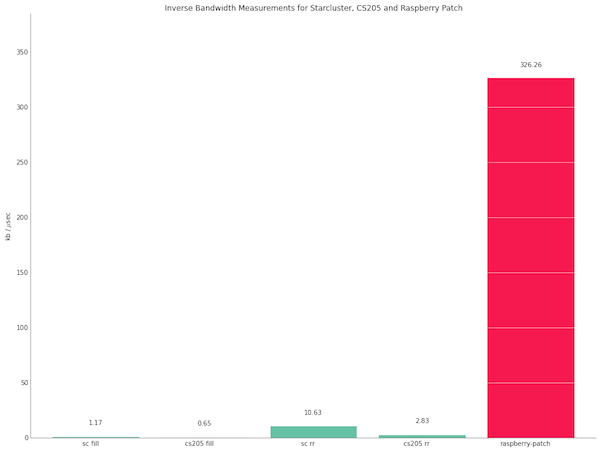
A Few Other Measures
In terms of GFLOPs/Cu.Ft. The Raspberry patch loses out to a server rack fitted with Intel CPUs:
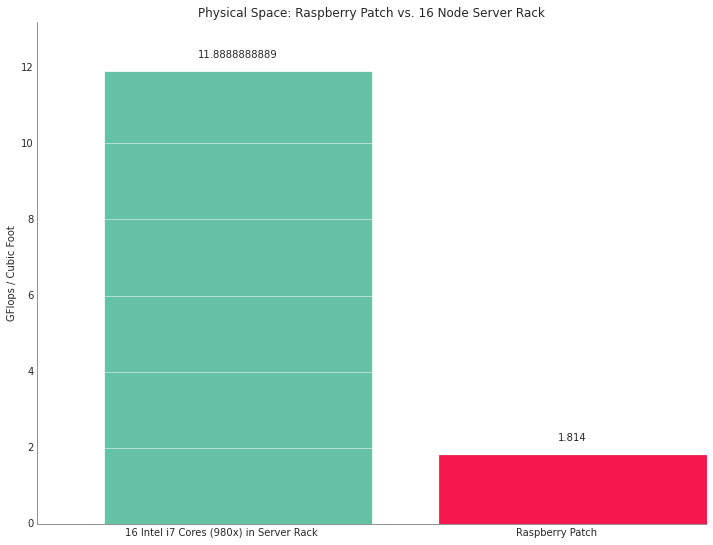
If we look at our power consumption, we still can’t beat out a core-i7 cluster in terms of GFLOPs/Watt:
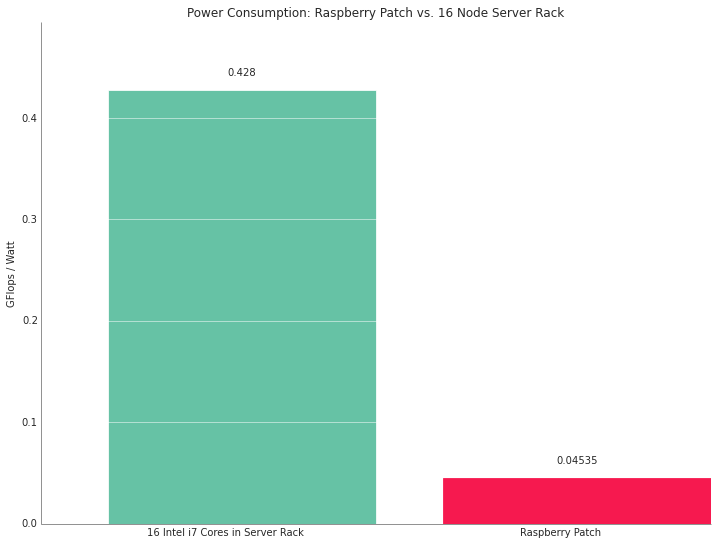
However, on the next graph, lower is better. This is the cost to replace a node if one of the cores fails:
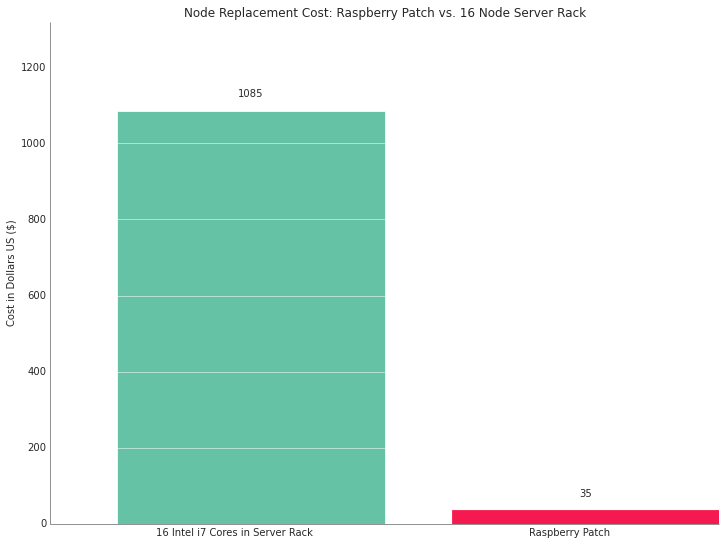
Finally, a victory!
